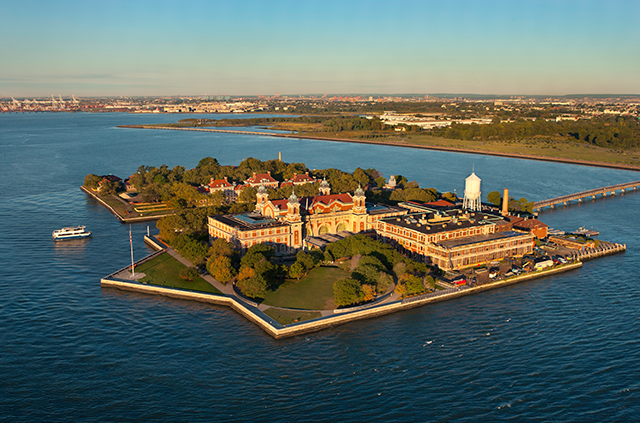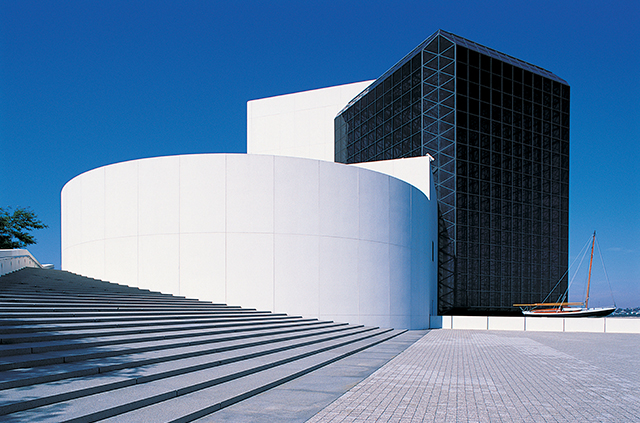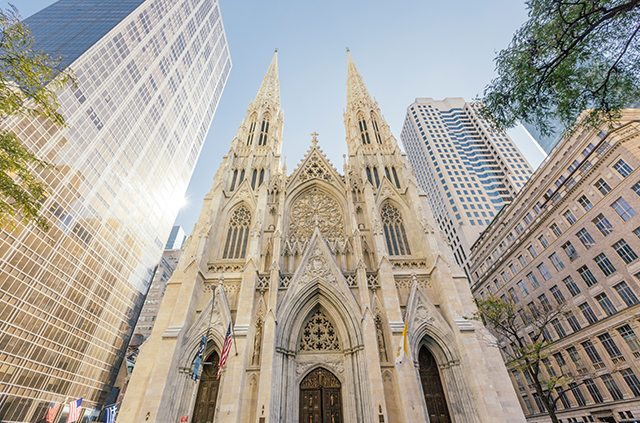It’s no secret the Northeast is home to a lot of people with Irish ancestry. Whether you’re Irish or just a history buff, you can walk in the footsteps of immigrants and notable Irish-Americans at these Irish museums, heritage sites and memorials.
Irish Hunger Memorial
New York, N.Y.
There are many statues and memorials to the victims of the Great Hunger in the Northeast, but none are quite as striking as the Irish Hunger Memorial in Battery Park. Designed by sculptor Brian Tolle and landscape architect Gail Witter-Laird, the memorial is like a piece of Ireland right in the middle of Lower Manhattan. The memorial, which looks like a gentle, grassy slope, features soil and vegetation from West Ireland.
Among the grasses, flowers and moss, you’ll find stones from every Irish county and even the ruin of an authentic, famine-era Irish cottage. The cottage was donated by the Slack family, Brian Tolle’s extended relatives who remained in Ireland. From the top of the slope, you can even see Ellis Island and the Statue of Liberty, reminding visitors of the journey that many Irish immigrants had to take to escape the ravages of the Great Hunger.
St. Patrick’s Cathedral
New York, N.Y.
St. Patrick’s Cathedral first opened its doors in 1879, and it remains the largest Gothic Revival Catholic cathedral in the country. Money for construction was donated by local immigrants and the children of immigrants – many of whom were Irish. It takes up a full city block in Midtown Manhattan and can accommodate 19,000 guests at a time.
A great way to experience St. Patrick’s Cathedral is through their audio tour. Just remember to be quiet and respectful, as it’s still an operating place of worship. While you’re in town, you can also visit St. Patrick’s Basilica on Mulberry Street, which was built between 1809 and 1815. Their catacomb tour is not to be missed.

Ellis Island
New York, N.Y.
Ellis Island, which operated from 1892 to 1954, was the first stop in America for over 12 million immigrants, including over 3.5 million Irish immigrants. Annie Moore, a 17-year-old from County Cork, Ireland, was actually the first immigrant to be processed there. Today, Ellis Island is a museum and archive, part of the Statue of Liberty National Monument.
Visitors to Ellis Island can experience their National Immigration Museum and Family History Center, which houses 65 million searchable immigration records. You might be able to find your family’s story amongst them.
The Tenement Museum
New York, N.Y.
Many immigrants to New York, like those who were processed through Ellis Island, would eventually wind up living in tenements. The Tenement Museum features two historic tenement buildings on the Lower East Side, with restored tenements representing different time periods and immigrant experiences. Learn about what life was like for immigrants of different cultural backgrounds from the 1860s to the 1980s. The museum also features neighborhood walking tours.
Boston Irish Famine Memorial
Boston, Mass.
The Boston Irish Famine Memorial is a small statue park between Washington Street and School Street, featuring two statues and eight plaques that tell the story of the Great Hunger and Irish diaspora. The statues, by sculptor Robert Shure, depict two families: a hungry family in Ireland and a family of Irish immigrants who have found success in America.
John Boyle O’Reilly Memorial
Boston, Mass.
John Boyle O’Reilly was a famous Irish writer and activist who made his home in Boston after escaping transportation to Australia in 1869. He had been transported for his ties to the Irish Republican Brotherhood, and continued his activism in Boston, where he became the editor of the newspaper “The Pilot.” He was known for his poetry, literature and journalism, and for popularizing the idea of Boston as an Irish cultural hub. His memorial, by sculptor Daniel Chester French, features a bronze bust of O’Reilly, as well as a bronze statue of Erin (the personification of Ireland) and her sons, Patriotism and Poetry.

John F. Kennedy Presidential Library and Museum
Boston, Mass.
As the first Irish Catholic president, JFK has a special place in Irish-American culture. At the John F. Kennedy Presidential Library and Museum, you can learn all about his life and legacy through exhibits that include the story of his youth, the presidential election, the space program, the oval office and first lady Jackie Kennedy.
Boston Irish Heritage Trail
Boston, Mass.
There’s probably more Irish history in Boston than anywhere else in America, and the Boston Irish Heritage Trail is a great way to experience it. The trail is a self-guided walking tour, stretching over 3 miles and 300 years of history. You can visit the Boston landmarks mentioned above, as well as the Rose Fitzgerald Kennedy Garden, the Boston Massacre Memorial, the Boston Public Library, Fenway Park and more.
Rhode Island Irish Famine Memorial
Providence, R.I.
The Rhode Island Irish Famine Memorial, also sculpted by Robert Shure, is a memorial wall and statue on Providence’s picturesque River Walk that commemorates the Great Hunger and the 1916 Easter Rising. It also features benches where visitors can reflect on the memorial, and the outlines of both Ireland and the United States on the walkway below.
The Museum of Newport Irish History
Newport, R.I.
As you might have guessed, the Museum of Newport Irish History tells the story of the Irish immigrants who settled in Newport, as well as their descendants. Visitors can enjoy exhibits on how Irish immigrants lived, worked, prayed and played. They also offer self-guided walking tours of Irish landmarks in Newport.
Planting Site of the First White Potato
Derry, N.H.
A humble plaque in front of the First Parish Church in East Derry, N.H., claims to be the planting site of the first white potato in North America. Potatoes were first cultivated in South America and transported to Europe, where they became a staple crop for peasants; however, it is believed that the first white potato in North America (also contemporarily known as the “Irish potato”) was planted in 1719 by Scots-Irish immigrants in this New Hampshire town.
Irish American Heritage Museum
Albany, N.Y.
The Irish American Heritage Museum explores the history, contributions and culture of Irish Americans. The museum has featured exhibits on the transformation of Samhain into Halloween, the Irish in the Adirondacks, Irish cooking, how to research your genealogy, the evolution of Irish dance costumes and so much more.
There are almost too many Irish memorials, museums and landmarks to mention in one article. What did we miss? Let us know in the comments below. Sláinte!
6 Thoughts on “Irish Museums and Heritage Sites in the Northeast”
Leave A Comment
Comments are subject to moderation and may or may not be published at the editor’s discretion. Only comments that are relevant to the article and add value to the Your AAA community will be considered. Comments may be edited for clarity and length.














Irish Cultural Centre Greater Boston,
loads of live music, an open session every Friday evening and events all year see calendar on website. https://www.irishculture.org
This was a good article about sites commemorating Irish history. One other site that you should include on your list is the Forbes House Museum in Milton. The house was the resident of Captain Robert Bennet Forbes, who led a national effort to send food and supplies to Ireland during the worse years of the famine. “Voyage of Mercy” by Stephen Puleo is a book that details Forbes’ efforts to raise support of Americans for Ireland during 1846-48. He captained the first ship of many to send food and other supplies to Ireland during those terrible years. His voyage transported 800 tons of desperately needed food to Cork. Other ships that followed took food and supplies to other Irish cities.
The Irish Cultural Center of the Mohawk Valley at 623 Columbia Street,Utica NY 13501..was founded over five years ago.It includes 2 floor cultural museum,plus Five Points Public House Restaurant and Bar,a replica of a restaurant/ bar in Dublin, Ireland. World Class!
Great article. Never forget that the Irish built this country – especially here on the East Coast. Go Irish!
The South Shore Irish Heritage Trail–featuring sites in 9 communities (from Weymouth to Plymouth) along the coastline south of Boston–was launched last year with support from the Republic of Ireland as well as the Commonwealth of Massachusetts. The “trail” is a combination of museums, monuments, and other sites to drive to/between, along with some self-guided or docent led walks through Irish immigrant neighborhoods with rich history. (I worked on the Irish walking tour for Hingham’s portion of the “trail.”)
There’s a monument in Manorville, NY in honor of Tom Clarke, one of the 1916 proclamation signers, executed by the British after the Rising. The site is on Tom’s farm in Manorville, where he lived in the late 1800’s. On the same site is a “Mass rock”, commemorating the Mass rocks which served as altars for surreptitious celebrations of the outlawed Catholic Mass during the times of the Penal Law.